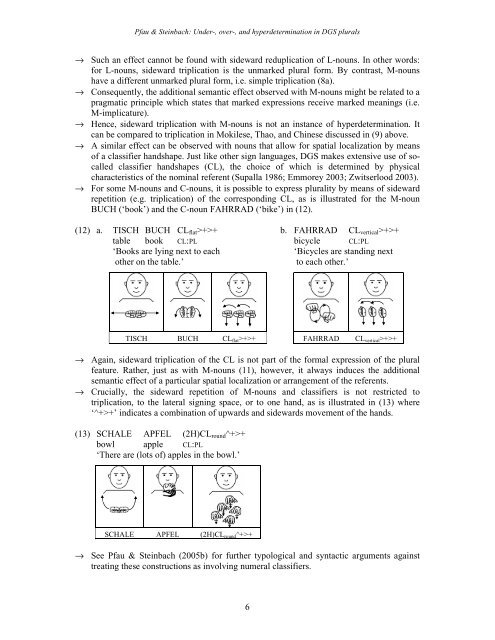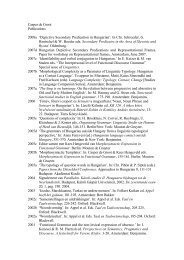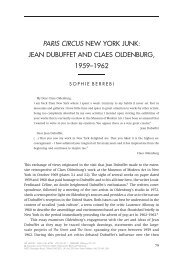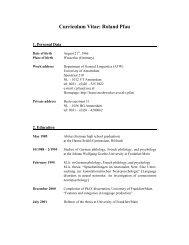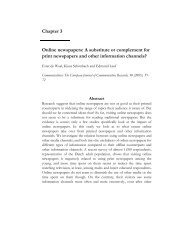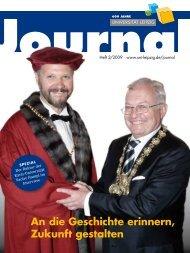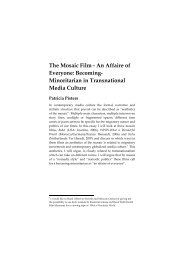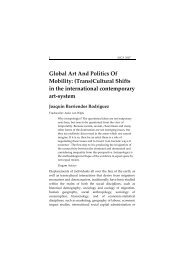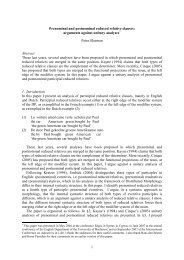Hyperdetermination in German Sign Language plurals
Hyperdetermination in German Sign Language plurals
Hyperdetermination in German Sign Language plurals
You also want an ePaper? Increase the reach of your titles
YUMPU automatically turns print PDFs into web optimized ePapers that Google loves.
Pfau & Ste<strong>in</strong>bach: Under-, over-, and hyperdeterm<strong>in</strong>ation <strong>in</strong> DGS <strong>plurals</strong><br />
→ Such an effect cannot be found with sideward reduplication of L-nouns. In other words:<br />
for L-nouns, sideward triplication is the unmarked plural form. By contrast, M-nouns<br />
have a different unmarked plural form, i.e. simple triplication (8a).<br />
→ Consequently, the additional semantic effect observed with M-nouns might be related to a<br />
pragmatic pr<strong>in</strong>ciple which states that marked expressions receive marked mean<strong>in</strong>gs (i.e.<br />
M-implicature).<br />
→ Hence, sideward triplication with M-nouns is not an <strong>in</strong>stance of hyperdeterm<strong>in</strong>ation. It<br />
can be compared to triplication <strong>in</strong> Mokilese, Thao, and Ch<strong>in</strong>ese discussed <strong>in</strong> (9) above.<br />
→ A similar effect can be observed with nouns that allow for spatial localization by means<br />
of a classifier handshape. Just like other sign languages, DGS makes extensive use of socalled<br />
classifier handshapes (CL), the choice of which is determ<strong>in</strong>ed by physical<br />
characteristics of the nom<strong>in</strong>al referent (Supalla 1986; Emmorey 2003; Zwitserlood 2003).<br />
→ For some M-nouns and C-nouns, it is possible to express plurality by means of sideward<br />
repetition (e.g. triplication) of the correspond<strong>in</strong>g CL, as is illustrated for the M-noun<br />
BUCH (‘book’) and the C-noun FAHRRAD (‘bike’) <strong>in</strong> (12).<br />
(12) a. TISCH BUCH CLflat>+>+ b. FAHRRAD CLvertical>+>+<br />
table book CL:PL bicycle CL:PL<br />
‘Books are ly<strong>in</strong>g next to each ‘Bicycles are stand<strong>in</strong>g next<br />
other on the table.’ to each other.’<br />
TISCH BUCH CLflat>+>+ FAHRRAD CLvertical>+>+<br />
→ Aga<strong>in</strong>, sideward triplication of the CL is not part of the formal expression of the plural<br />
feature. Rather, just as with M-nouns (11), however, it always <strong>in</strong>duces the additional<br />
semantic effect of a particular spatial localization or arrangement of the referents.<br />
→ Crucially, the sideward repetition of M-nouns and classifiers is not restricted to<br />
triplication, to the lateral sign<strong>in</strong>g space, or to one hand, as is illustrated <strong>in</strong> (13) where<br />
‘^+>+’ <strong>in</strong>dicates a comb<strong>in</strong>ation of upwards and sidewards movement of the hands.<br />
(13) SCHALE APFEL (2H)CLround^+>+<br />
bowl apple CL:PL<br />
‘There are (lots of) apples <strong>in</strong> the bowl.’<br />
SCHALE APFEL (2H)CLround^+>+<br />
→ See Pfau & Ste<strong>in</strong>bach (2005b) for further typological and syntactic arguments aga<strong>in</strong>st<br />
treat<strong>in</strong>g these constructions as <strong>in</strong>volv<strong>in</strong>g numeral classifiers.<br />
6


